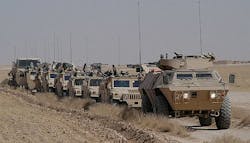Army surveys industry for products and services for new vetronics navigation technologies
Officials of the Army Contracting Command in Warren, Mich., issued a request for information (W56HZV-RFI-VNS) on Friday for the Vehicle Navigation System for Army Platforms project.
Army researchers want to hear from companies about potential products and solutions that could help combine a VICTORY-compliant service provider with trusted positioning, navigation, and timing (PNT) data for all systems in the vehicle that require it.
The vetronics navigation system should be able to fit aboard the Army's High Mobility Multipurpose Wheeled Vehicle (HMMWV), Family of Medium Tactical Vehicles (FMTV), Mine Resistant Ambush Protected (MRAP), Joint Light Tactical Vehicle (JLTV), M113, Armored Multi-Purpose Vehicle (AMPV), M1 Abrams tank, M2 Bradley Fighting Vehicle, and Stryker Family of Vehicles, Army officials say. VICTORY is short for Vehicle Integration for C4ISR/EW Interoperability standard.
Army experts would like to capitalize on recent industry technology development for VNS capability that could apply to Army operational environments.
Technical requirements of the VNS include reducing the power of broadband, narrow band, carrier wave (CW), pulsed CW, swept CW, and spectrally matched jammers when using anti-jam antennas.
Researchers also would like the ability to replace existing GPS receivers with future Military GPS User Equipment (MGUE) anti-jam receivers. Also required will be the ability to integrate positioning, navigation, and timing (PNT) sensors into a unified PNT solution that could include celestial, precision clock, ranging, cameras/vision navigation, and inertial measurement unit (IMU) sensors.
Researchers also would like to receive C/A-, and P(Y) navigation code and pseudolite signals in L1 and L2 frequency bands that are compatible with Spot Beams. These VNS units also should support upgrades to an M-code receiver; have an interface to control, monitor, and test interface with GPS receiver, host platform, and test applications.
These VNS devices should be able to provide VICTORY 1.6.2 services and components like position, orientation, direction of travel, GPS, , and shared processing unit. Researchers also want the ability to support network time protocol (NTP) and precision time protocol (PTP), as well as the ability to support other global navigation satellite systems (GNSS).
Related: U.S. Army TACOM chooses KVH TACNAV navigation systems for combat vehicles
As the industry's Vehicle Navigation System development efforts proceed further, the Army will look for the best solution in terms of the performance, SWaP-Cost and schedule. The Army seeks information from industry on Vehicle Navigation System technologies and products deemed applicable to the Army platforms.
Companies with relevant products or services should email responses no later than 4 April 2016 to the Army's Nikia Williams at [email protected].
Email questions or concerns to Williams at [email protected], or to The Army's James Giacchina at [email protected].
More information is online at https://www.fbo.gov/notices/3d0715580eca58d61a1053db158fb5c1.
